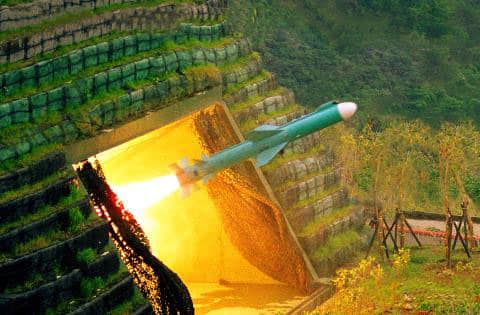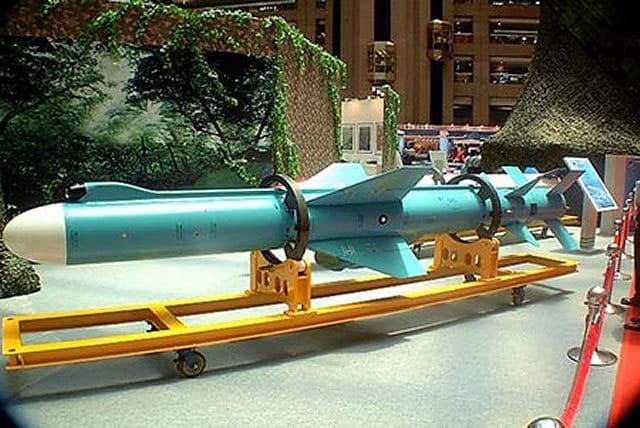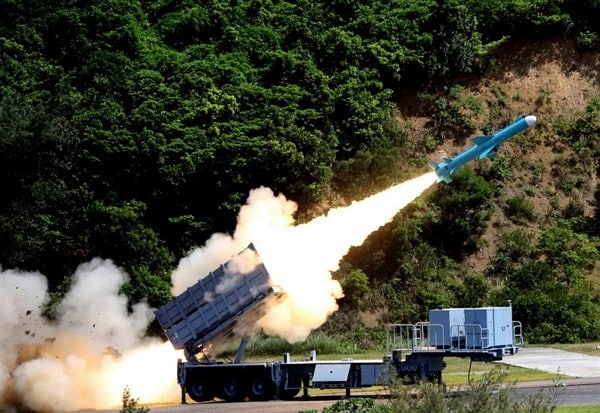The Hsiung Feng IIE is a subsonic land-attack cruise missile. It is among Taiwan’s longest range missiles, and is the only one of Taiwan’s Hsiung Feng cruise missile variants specifically designed for land-attack missions.
Hsiung Feng IIE at a Glance
- Originated from
- Taiwan
- Possessed by
- Taiwan
- Alternative names
- Hsiung Feng IIE, Brave Wind IIE
- Class
- Subsonic land-attack cruise missile
- Basing
- Ground-launched, road-mobile
- Length
- 6 m (IIER – 6.25 m)
- Diameter
- 0.50 m
- Launch weight
- Unitary warhead, 200 kg (IIER – 400-450 kg)
- Payload
- 225 kg, Semi-armor piercing High Explosive, Fragmentation
- Propulsion
- Solid-propellant booster, liquid-fueled turbojet engine
- Range
- 600 km (extended range variant – 1,200 km)
- Speed
- 290 m/s
- Status
- Operational
- In service
- 2011-Present

An HF-2E missile is test launched. 
An HF-2E missile on display. 
Hsiung Feng IIE missile launch. Photo: NCSIST
Hsiung Feng IIE Development
The Hsiung Feng IIE program likely started in 2001 to give Taiwan the ability to strike targets deeper in mainland China. Prior to its development, most Taiwanese missiles could only reach a few hundred kilometers, limiting strike capabilities to coastal areas. The extended range of the Hsiung Feng IIE makes it possible for the Taiwanese military to target surveillance and reconnaissance assets, radar, missile sites, airfields, and other critical PLA installations.1
The Hsiung Feng IIE was developed by the National Chung-Shan Institute of Science and Technology (NCSIST).
Despite its name, the Hsiung Feng IIE does not appear to be derived from the Hsiung Feng II, but rather a different line of design entirely, which bears many similarities to the U.S. Tomahawk (RGM-109) cruise missile. According to one source, the Hsiung Feng IIE designation was intentionally used to divert attention away from the true nature of the project – creating a longer-range strike capability.2
The Hsiung Feng IIE was reportedly test-fired for the first time in June 2005.3 According to Chinese media, Taiwan also successfully test-fired the missile in October 2007.4 An extended 800-km range version was tested in January 2008.5
The missile’s development was quickly met with strong resistance from the United States, which has at times expressed reservations about Taiwan’s offensive capabilities.6
Nevertheless, Taiwan continued to proceed with the program. Some analysts have linked continued Hsiung Feng IIE development to Washington’s refusal to sell Taiwan the F-16C/Ds, which Taiwan had been seeking since 2006. It is also possible that Washington’s initial refusal to sell more of the advanced fighter jet to Taiwan was a result of Taipei’s decision to embark on the Hsiung Feng IIE program.7
Due to changing regional security dynamics, however, U.S. concerns over Taiwan’s offensive missile programs have lessened in recent years.8
On November 1, 2018, Taiwanese Upmedia news agency reported that an extended range HF-2E was near completion of first-phase production. At least 100 of these missiles were set to be produced, with a budget of about US$440 million. These missiles, with an extended range of over 1,200 km, would significantly increase Taiwan’s ability to strike targets deep into the Chinese mainland.9 In January 2021, Taiwan military officials stated that small quantities of the upgraded missile were deployed.10
Specifications
The Hsiung Feng IIE has a length of 6.0 m, a body diameter of 0.50 m, and a launch weight of 980 kg. The missile carries a single warhead of approximately 200 kg. Most sources put its range at 600 km, although a 2017 U.S. National Air and Space Intelligence Center report lists the HF-2E range at 300 km.11
The missile is based on a mobile, land platform and is propelled by a solid-fueled booster and liquid-fueled turbojet engine. The missile is guided by INS/GPS and uses terrain matching technology to improve strike accuracy. 12 According to one analyst, it has a pre-terminal accuracy of 15 m CEP.13
Service History
The Hsiung Feng IIE entered low-rate initial production in 2009, with a target output of 50 missiles before 2010. Full-rate production began around 2011.14
Little is known about its present deployments beyond a March 2018 deployment to Taiwan’s Taoyuan city near Taipei as a response to rising tensions between the island and mainland China.15
Footnotes
- “These are the 9 Killer Weapons China and Taiwan Would Use in a War,” The National Interest, December 10, 2016, http://nationalinterest.org/blog/the-buzz/these-are-the-9-killer-weapons-china-taiwan-would-use-war-18701.
- Fu S. Mei, “Towards a Counter-Deterrent Capability Part I,” Taiwan Defense Review, June 21, 2001.
- “Hsiung Feng I/II/IIE/III,” in IHS Jane’s Weapons: Naval 2016-2017, ed. David Ewing & Malcolm Fuller (United Kingdom: IHS, 2016), 118-122.
- Russell Hsiao, “China-Taiwan Up Missile Ante,” The Jamestown Foundation, April 1, 2010, https://jamestown.org/program/china-taiwan-up-missile-ante/.
- Ibid.
- J. Michael Cole, “More Missiles for Asia,” The Diplomat, October 8, 2012, http://thediplomat.com/2012/10/south-korea-and-a-new-asian-missile-game/.
- Cole, “More Missiles for Asia” ; J. Michael Cole, “How to Deter Taiwan Clash,” The Diplomat, April 18, 2012, http://thediplomat.com/2012/04/how-to-deter-taiwan-clash/.
- Russell Hsiao, “Taiwan Reportedly Plans to Upgrade Supersonic Hsiung Feng III Missiles,” The National Interest, October 20, 2016, http://nationalinterest.org/blog/the-buzz/taiwan-reportedly-plans-upgrade-supersonic-hsiung-feng-iii-18120.
- Nick Aspinwall, “Taiwan Is Building Long Range Cruise Missiles That Aim Deep Inside China,” The News Lens, November 15, 2018, https://international.thenewslens.com/article/108186.
- Kelvin Chen, “Taiwan military has begun deploying extended-range cruise missiles,” Taiwan News, January 11, 2021, https://www.taiwannews.com.tw/en/news/4099431.
- “Ballistic and Cruise Missile Threat,” National Air and Space Intelligence Center, June 2017, http://missilethreat.csis.org/wp-content/uploads/2017/06/06262017_nasic.pdf.
- IHS Jane’s Weapons: Naval 2016-2017, 118-122.
- Fu S. Mei, “HF-2E Cruises Along,” Taiwan Defense Review, March 27, 2007.
- IHS Jane’s Weapons: Naval 2016-2017, 118-122; “Taiwan: Overview,” Nuclear Threat Initiative, May 2015, http://www.nti.org/learn/countries/taiwan/.
- “Taiwan is reportedly readying its cruise missiles for armed conflict with China, but it’s probably not enough to save the island in a fight,” Business Insider, August 8, 2018, https://www.businessinsider.com/taiwan-seen-readying-its-cruise-missiles-for-armed-conflict-with-china-2018-8